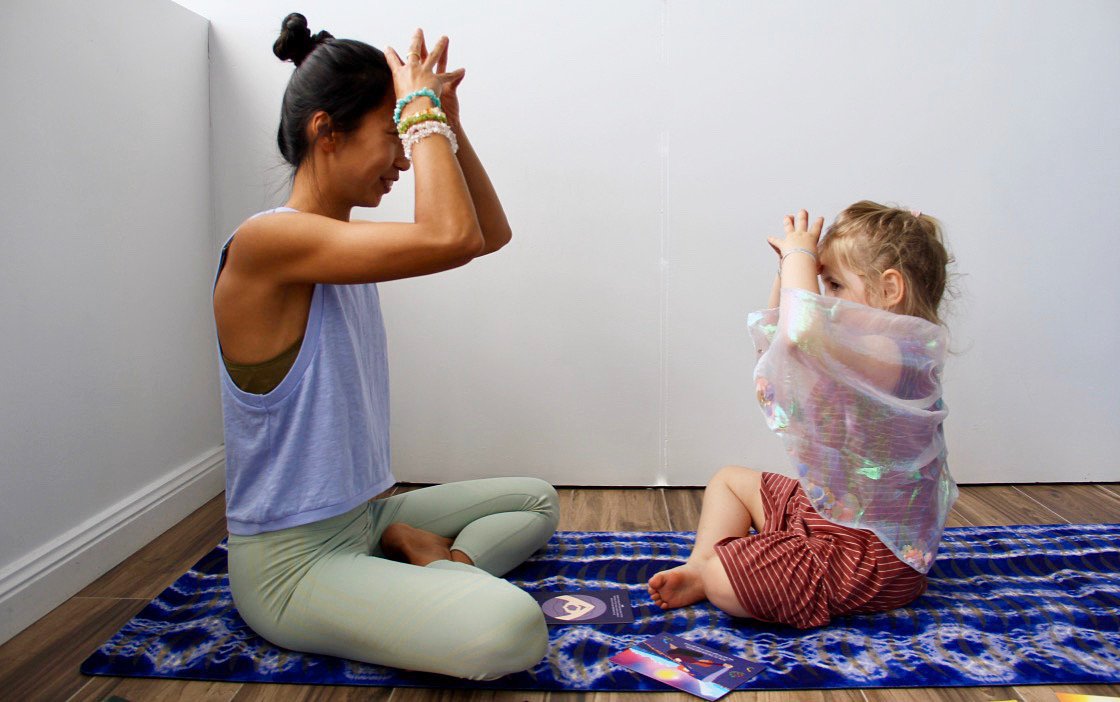Sa Ta Na Ma Meditation
A classic meditation for all ages that is simple to remember and wonderfully soothing. It combines mudras with mantras to make it even more powerful.
Sa Ta Na Ma is one of my favourite meditations to do with children.
Also known as Kirtan Kriya, it is a mantra meditation technique used in Kundalini yoga that stimulates the senses and parts of the brain. It involves a combination of chanting primal sounds repeatedly (Sa Ta Na Ma) and mudras (yoga poses with your hands or a “dance with the hands”).
It is regarded as a transformative mantra as it is believed the five sounds have the power to transform you, help you replace negativity with positivity in your life.
How to practice the Kirtan Kriya technique:
• Sit comfortably with your spine straight and take a cleansing breath to start.
• Chant Sa, Ta, Na, Ma as you make mudras with your fingers.
As you chant Sa, connect the index fingers of each hand to your thumbs.
As you chant Ta, connect the middle fingers of each hand to your thumbs.
As you chant Na, connect the ring fingers of each hand to your thumbs.
As you chant Ma, connect the pinky fingers of each hand to your thumbs.
• Repeat this a few times until you find a nice rhythm. Try closing your eyes too for a deeper connection.
• End the exercise with a big breath in as you reach your hands up to the sky. Exhale as you slowly let your hands float back down to your knees.
Image above via Pinterest
WHAT DOES SA TA NA MA MEAN?
“Sa” means birth, beginning; “Ta” means life, creativity and existence; “Na” means death and change; and “Ma” is rebirth, regeneration, as well as consciously experiencing the joy of the infinite.
The sounds come from the mantra “Sat Nam” which translates to “my true essence’ or “my true identity”.
It is also understood to mean that when chanting Sa Ta Na Ma, you are shedding or letting go of the old you, and becoming who you are meant to be - your true self. You are reaffirming “this is me, my true self”.
BENEFITS:
The simultaneous finger-tapping and chanting is believed to enhance blood flow to the brain, improve cognition, focus and memory and boost one’s mood.
It brings clarity and balance to the mind.
By placing the tongue on the roof of the mouth while reciting the mantra, it stimulates 84 acupuncture meridian points on the palate which sends a signal to the hypothalamus, pituitary gland, and other areas of the brain. The nerve endings in the fingertips, lips, and tongue activate the motor and sensory areas of the brain.
A study found that this meditation can help patients with Alzheimer’s disease - increase cognitive function, improve short-term memory and reduce stress.
Mudra practises are focused on energy channels and pressure points in the body. By putting gentle pressure on the fingertips, it stimulates greater energy flow from the body to the brain.
Want to take this mediation to the next level?
Below are a couple different elements to explore:
The 3 VOICES
1) Your singing voice - the voice of action.
2) Your whispered voice - the voice of your inner mind.
3) Your silent voice - this is your spiritual voice. Say the mantra silently to yourself.
When teaching children, I explore each of these 3 voices with them.
With teens and adults, you can try the below:
Chant Sa Ta Na Ma out loud for 2 mins using your singing voice.
Chant the mantra as a whisper for 2 mins.
Chant the mantra silently to yourself for 4 mins.
Chant the mantra in a whisper for 2 mins.
Chant the mantra out loud for 2 mins.
After approx. 12 mins, close the exercise with a big breath in as you reach your hands up to the sky. Exhale as you slowly let your hands float back down to your knees.
The MUDRAS
The four fingers used in the meditation each symbolise something unique:
“Sa” – the index finger – represents wisdom
“Ta” – the middle finger – represents patience
“Na” – the ring finger – represents energy
“Ma” – the pinky finger – represents communication
CHAKRA VISUALISATION
As you chant each syllable, imagine the sound vibrations and energy flowing in and entering through the top of your head, your crown chakra (sahasrara) and out the middle of your forehead between your eyebrows, through your third eye chakra (ajna). We focus on these two chakras as these are where our enlightenment, spiritual connection and intuition reside.
Try out this lovely meditation with your children and your students and witness as they become mesmerised by the soothing sounds and how their concentration improves. I love doing this meditation myself to help focus my mind when it’s overwhelmed and busy. I immediately feel a sense of calm when I practise this for a couple minutes.
Listen to it here by Tera Naam
Enjoy x
Want to learn about the mudras for the 7 chakras?
Check out the 7 Chakra mudras featured in our Rainbow Chakra Yoga & Mindfulness Card deck. Shop here.










